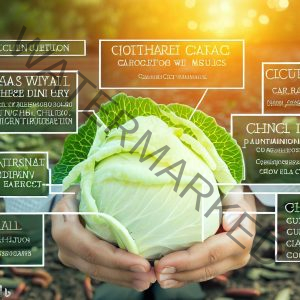Starting a cabbage farming business can be a lucrative venture for individuals interested in agriculture and seeking opportunities in the horticulture industry. Cabbage is a highly nutritious vegetable widely consumed worldwide and has a high demand in various culinary dishes.
This article aims to provide you with a comprehensive guide to developing a successful cabbage farming business plan, covering everything from market analysis to cultivation techniques and marketing strategies.
[Pdf Sample] Cabbage Farming Business Plan Proposal Docx
To write a business plan, here is a breakdown of how it should be structured and what should be in each category. After this instruction, I will provide you with a sample of one I wrote for my farm, let us go:
Read Also: [Pdf Sample] Business Plan For Tomato Greenhouse Docx

1. Executive Summary
The executive summary provides a brief overview of your cabbage farming business plan, highlighting key points such as the objective of your business, target market, unique selling proposition, and financial projections. It serves as a snapshot of your entire plan, giving readers a glimpse into your venture.
2. Market Analysis
Understanding the market is essential for any successful business. In this section, we will delve into the demand for cabbage, identify target markets, and assess competitors. By conducting thorough market research, you can make informed decisions regarding production levels, pricing strategies, and marketing efforts.
Read Also: [Pdf Sample] Business Plan For Vegetable Farming Docx
Understanding the Demand for Cabbage
Cabbage is a versatile vegetable that is used in various cuisines worldwide. It is known for its high nutritional value and culinary versatility, making it a staple ingredient in many households, restaurants, and food processing industries. Analyzing the demand for cabbage helps you identify the potential customer base and tailor your production to meet their requirements.
Identifying Target Markets
Identifying your target markets is crucial for effective marketing and sales strategies. Explore local and regional markets, including retail outlets, restaurants, schools, and catering services. Additionally, consider exploring opportunities in the wholesale market, where you can supply cabbage in bulk to larger buyers such as supermarkets and food processors.
Read Also: [Pdf Sample] Business Plan Guide For Strawberry Farming Docx
Assessing Competitors
Research and analyze your competitors to gain insights into their strengths, weaknesses, and market positioning. By understanding the competitive landscape, you can differentiate your cabbage farming business by offering unique varieties, superior quality, or competitive pricing. This analysis will also help you identify gaps in the market that you can capitalize on.
3. Setting Up Your Farm
Before commencing cabbage cultivation, it is crucial to set up your farm infrastructure and make necessary preparations. This section will guide you through key considerations such as selecting an appropriate location, acquiring suitable land, and procuring the necessary equipment and infrastructure.
Read Also: [Pdf Sample] Business Plan For Bell Pepper Farming Docx
Location and Land Requirements
Choose a location that offers suitable climatic conditions and access to essential resources like water and transportation. Cabbage thrives in cool weather conditions, so regions with moderate temperatures and well-drained soil are ideal. Ensure that the land you acquire has sufficient space for expansion and meets the requirements for cabbage cultivation.
Equipment and Infrastructure
Invest in the necessary equipment and infrastructure to support your farming operations. This includes machinery for land preparation, irrigation systems, storage facilities, and transportation vehicles. Adequate infrastructure ensures smooth operations and helps maintain the quality of your cabbage produce.
Read Also: [Pdf Sample] Business Plan For Chili Pepper Farming Docx
Seed Selection and Procurement
Select high-quality cabbage seeds from reputable suppliers or develop your own seed production capabilities. Consider factors such as disease resistance, yield potential, and suitability to your local climate. It is advisable to maintain a seed bank to ensure a consistent supply of quality seeds.
4. Cultivation Techniques
To achieve optimal cabbage yields and maintain product quality, proper cultivation techniques must be employed. This section will outline essential practices such as soil preparation, fertilization, planting, irrigation, pest and disease control, and crop rotation.
Soil Preparation and Fertilization
Prepare the soil by removing weeds, rocks, and debris. Conduct a soil test to determine its nutrient composition and pH level. Based on the test results, amend the soil with organic matter and appropriate fertilizers to ensure the right nutrient balance for cabbage growth.
Planting and Transplanting
Start cabbage cultivation by sowing seeds in seed trays or directly in nurseries. Once the seedlings reach the appropriate size, transplant them into the main field. Ensure proper spacing between plants to allow sufficient air circulation and minimize competition for nutrients.
Irrigation and Water Management
Cabbage requires consistent moisture throughout its growth cycle. Implement an irrigation system that provides adequate water while avoiding waterlogging. Monitor soil moisture levels regularly and adjust irrigation schedules accordingly.
Pest and Disease Control
Protecting cabbage plants from pests and diseases is crucial to ensure healthy growth and high-quality produce. Employ integrated pest management techniques, including biological controls, cultural practices, and judicious use of pesticides. Regularly monitor plants for signs of pest infestation or disease symptoms and take appropriate action promptly.
5. Harvesting and Post-Harvest Management
Knowing the right time to harvest cabbage and employing proper post-harvest management techniques are vital to preserve the quality and shelf life of the produce. This section will guide you through the harvesting process and highlight essential practices for handling, packaging, storage, and transportation.
Determining the Right Time to Harvest
Harvest cabbage when the heads reach the desired size and are firm to the touch. Avoid delaying harvest as over-mature heads can become tough and less marketable. Regularly monitor the field and conduct trial harvests to determine the optimal harvest time.
Handling and Packaging
Handle harvested cabbage with care to minimize damage and maintain freshness. Remove outer leaves, clean the heads, and sort them according to size and quality. Pack the cabbage in appropriate containers or packaging materials to protect it during transportation.
Storage and Transportation
Cabbage has a relatively short shelf life and requires proper storage conditions to prevent spoilage. Maintain a cool and humid environment, ideally around 32°F (0°C) and 95% relative humidity, to extend its shelf life. Properly package and transport the cabbage to market swiftly to ensure its freshness.
6. Marketing and Sales Strategies
To establish a successful cabbage farming business, effective marketing and sales strategies are essential. This section will guide you through branding and positioning your farm, developing distribution channels, pricing your produce competitively, and promoting your cabbage to reach potential buyers.
Branding and Positioning
Develop a unique brand identity for your cabbage farm that reflects its values, quality, and distinct offerings. Differentiate your farm by highlighting factors such as organic practices, sustainable farming methods, or locally sourced produce. Position your cabbage as a premium product to target customers seeking high-quality vegetables.
Developing Distribution Channels
Identify and establish suitable distribution channels to reach your target markets effectively. Collaborate with local retailers, restaurants, and wholesalers to supply cabbage directly. Consider participating in farmers’ markets or establishing online sales platforms to reach a broader customer base.
Pricing and Promotion
Set competitive pricing for your cabbage while considering factors such as production costs, market demand, and competitors’ prices. Develop promotional strategies to create awareness and generate interest in your cabbage, including social media marketing, collaborations with influencers, and participating in relevant agricultural events.
7. Financial Planning
Financial planning is crucial for the sustainability and growth of your cabbage farming business. This section will help you create a comprehensive budget, analyze costs and revenues, and manage potential risks to ensure long-term profitability.
Budgeting and Cost Analysis
Develop a detailed budget that includes expenses for land acquisition, infrastructure setup, equipment purchase, seed procurement, labor, marketing, and other operating costs. Conduct a cost analysis to estimate the break-even point and determine the pricing strategy for your cabbage produce.
Revenue Projection
Based on market analysis and production estimates, project your revenue potential for each harvest cycle. Consider seasonal variations, market trends, and potential demand fluctuations to make accurate revenue projections.
Risk Management
Identify potential risks that may affect your cabbage farming business and develop strategies to mitigate them. These risks may include adverse weather conditions, pest outbreaks, market fluctuations, or operational challenges. Implement risk management practices such as insurance coverage, diversification of crops, and contingency plans.
Here Is The Download Link To Business Plan Proposal For Cabbage Farming By Agrolearner
Business Model: Agrolearners.com Cabbage Farming Business
Value Proposition:
Agrolearners.com offers high-quality, fresh, and organic cabbage to meet the increasing demand of health-conscious consumers in the local and international markets. Our commitment to sustainable farming practices, customer satisfaction, and superior taste sets us apart from competitors.
Customer Segments: Our primary customer segments include:
Local households: Individuals and families seeking fresh, organic produce for their daily consumption.
Restaurants and hotels: Establishments that prioritize quality ingredients to serve their customers.
Grocery stores: Retailers looking for reliable suppliers of cabbage to meet the demand of their customers.
Export markets: Neighboring regions and countries that have a demand for locally grown cabbage.
Key Activities:
Cabbage cultivation: Implementing modern cultivation techniques, including soil preparation, planting, irrigation, pest and disease control, and harvest management.
Quality control: Conducting regular inspections, monitoring, and testing to ensure the highest quality standards for our cabbage.
Marketing and sales: Developing marketing strategies, branding, distribution channels, and customer relationship management to promote and sell our cabbage.
Research and development: Continuously exploring innovative farming techniques, improving crop yield, and enhancing product quality.
Key Resources:
Land: Acquiring suitable land with favorable climate conditions and ample acreage for cabbage cultivation.
Infrastructure: Establishing necessary facilities, including greenhouses, storage units, and cold storage for proper post-harvest management.
Equipment: Investing in farming equipment such as tractors, irrigation systems, and harvesting tools to optimize productivity and efficiency.
Seeds: Procuring high-quality cabbage seeds from reliable suppliers.
Skilled labor: Hiring experienced farmers and agricultural experts to ensure proper cultivation and management of the farm.
Partnerships:
Seed suppliers: Collaborating with reputable seed providers to obtain high-quality, disease-resistant cabbage seeds.
Distribution partners: Building strong relationships with local grocery stores, restaurants, hotels, and export agents to ensure reliable and efficient delivery of our cabbage.
Research institutions: Collaborating with agricultural research organizations to stay updated on the latest farming techniques, pest control methods, and seed varieties.
Channels:
Direct sales: Selling cabbage directly to consumers through an online platform, farm stands, and on-site sales.
Distribution networks: Partnering with grocery stores, restaurants, hotels, and export agents to reach a wider customer base.
Online presence: Utilizing Agrolearners.com’s website and social media platforms to promote our cabbage and engage with customers.
Revenue Streams:
Product sales: Generating revenue through the sale of fresh cabbage to individual consumers, restaurants, hotels, and grocery stores.
Export sales: Expanding revenue streams by exporting cabbage to neighboring regions and countries with a demand for high-quality produce.
Cost Structure:
Farm operation costs: Including land lease or purchase, labor expenses, utility bills, and ongoing maintenance of equipment and infrastructure.
Marketing and sales costs: Allocating budget for marketing campaigns, branding, promotions, and customer acquisition.
Research and development costs: Investing in research, experimentation, and continuous improvement of farming techniques and product quality.
Distribution costs: Covering transportation, packaging materials, and distribution logistics.
Key Metrics:
Yield per acre: Monitoring and optimizing cabbage yield to ensure productivity and profitability.
Customer satisfaction: Measuring customer feedback, reviews, and repeat purchases to gauge satisfaction levels.
Sales volume and revenue: Tracking the number of units sold and total revenue generated.
Market share: Assessing our market presence and the percentage of the cabbage market we capture.
Cost efficiency: Analyzing production costs, operational expenses, and identifying areas for cost optimization.
By implementing this business model, Agrolearners.com aims to establish a sustainable and profitable cabbage farming business that meets the needs of health-conscious consumers while contributing to the local and international food supply chain.
What are the ideal climatic conditions for cabbage cultivation?
Cabbage thrives in cool weather conditions with temperatures between 45°F (7°C) and 75°F (24°C).
How long does it take for cabbage to mature?
The time taken for cabbage to mature varies depending on the variety, but it typically ranges from 70 to 100 days.
Can cabbage be grown organically?
Yes, cabbage can be grown using organic farming practices, which avoid the use of synthetic pesticides and fertilizers.
How can I prevent common pests and diseases in cabbage?
Implement integrated pest management techniques, such as crop rotation, companion planting, and regular monitoring, to minimize pest and disease issues.
What are some popular cabbage varieties?
Popular cabbage varieties include Green Acre, Early Jersey Wakefield, Red Express, Savoy, and Napa cabbage.
Conclusion
In conclusion, Agrolearner.com Farm’s detailed cabbage farming business plan outlines our strategic approach to meeting the increasing demand for high-quality cabbage in our target market. By focusing on modern cultivation techniques, efficient resource management, strong branding, and effective marketing strategies, we are confident in our ability to achieve long-term success.
We are committed to providing fresh, organic cabbage to our customers, contributing to their health and well-being while establishing Agrolearner.com Farm as a leading supplier in the industry.




One Reply to “[Pdf Sample] Business Plan For Cabbage Farming Docx”